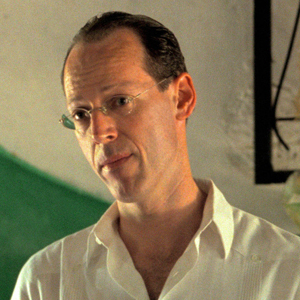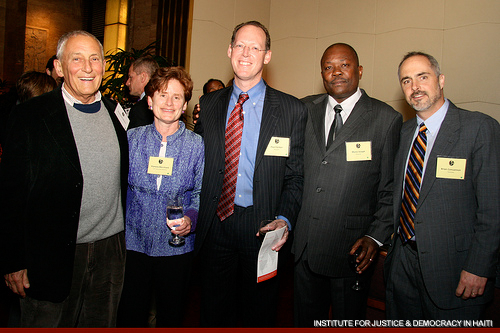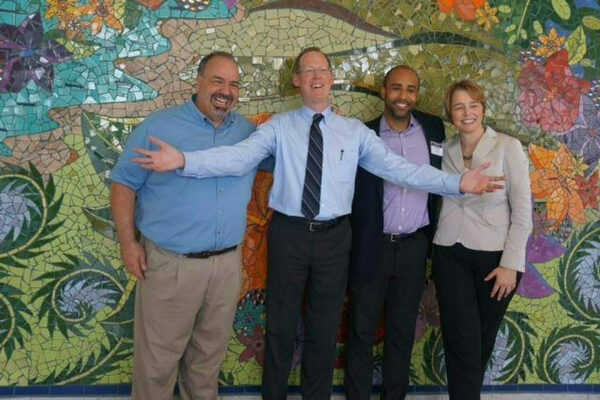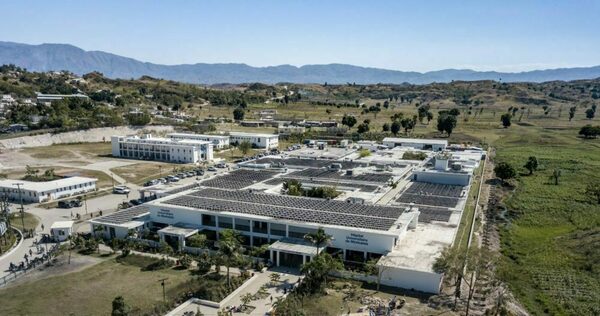
The world who knew Paul Farmer through his work, his writing, and his organization Partners in Health have been mourning the news of his loss over the past week. He was, of course, a doctor but he was also an anthropologist and ethicist. As a doctor, he wanted to heal but he wanted to do so smartly and sustainably. As an anthropologist, he wanted to understand the historical, economic, political, and cultural context of disease. And as an applied ethicist, he wanted to understand why preventable disease was allowed to ravage communities of the poor. For him, medicine was a moral calling that moved him to seek out the most morally compelling health challenges in the most difficult contexts.
For those of us in the field of development, Paul was a special person. He was a radical, an iconoclast, a prophet, a truthteller. He said loudly and boldly what most development professionals know but are often afraid or unable to say. Paul forged his own path and in so doing, he spoke truth to power humbly but effectively. His example made it easier for others to follow in his path, challenge conventional thinking, acknowledge failure, and seek new and better solutions to seemingly intractable problems.
Paul was a man of faith inspired by the call of liberation theology to opt for the poor and sought to model this through the healing actions of his approach to medicine. For Paul, liberation was about the realization of human rights — both political and civil — as well as economic, social, and cultural rights. He publicly championed the right to health, which for him meant true equal access to quality and affordable healthcare for all, not just for those who could afford it. He viewed the failure of societies to ensure the realization of such equal access and condoning preventable disease and “stupid deaths” (a Haitian phrase) among the poor as a human rights violation that called for accountability. He saw the failure of societies to build these kinds of inclusive health systems as, at best, a failure of imagination and, at worst, a form of structural social exclusion and violence. Paul saw his vocation as twofold: healing the sick and reforming the sick societies that sustained these forms of structural violence.
Many eloquent tributes have been written about Paul over these past several weeks. While I knew Paul as a professional colleague from a variety of encounters over the years, there are others who worked with him very closely over decades and knew him far more deeply and profoundly than me. I thought our best tribute to him would be to share remembrances from two of those individuals: Brian Concannon, the Executive Director and Founder of the Institute for Democracy and Justice in Haiti, and Jim Ansara, the Executive Director and founder of Build Health International. Brian worked with Paul over several decades related to their shared interest in Haiti and Jim took on the role of designing and building the large Partners in Health hospital in Mirebalais, Haiti that is now the center of Paul’s legacy to the Haitian people. Both have written very personal and moving remembrances of Paul, that they have kindly given us permission to share. We are most grateful to them both.
Remembering Paul Farmer
Brian Conannon
On the day after Christmas, 2005, Paul Farmer hiked up a mountain in Rwanda until his phone showed enough bars to call me in Colorado. Paul wanted to talk about Fr. Gerard Jean-Juste, a Catholic priest and Haiti’s most effective advocate for non-violent social change. Fr. Gerry, as he was known, like Paul, subscribed to liberation theology, which reads the bible as compelling us to fight the worldly policies that make impoverished people such as Paul’s patients and Fr. Gerry’s parishioners excessively vulnerable to disease and other injustice.
Fr. Gerry had been thrown in prison months earlier for speaking out against the repression of Haiti’s unconstitutional, US-installed regime. When a courageous judge ordered Fr. Gerry free because there was no evidence, the government fired the judge, and refused to allow subsequent hearings for the priest. Father Gerry became ill in prison. In early December a doctor permitted to conduct a quick exam reported he likely had leukemia. Members of Congress wrote President Bush, urging him to use his influence with the Haitian government. But the Haitian regime, backed the US, insisted that Fr. Gerry was receiving adequate care.
On his way out of Haiti to go to Rwanda for Christmas, Paul had visited Fr. Gerry. The prison guards watched Paul closely to enforce his promise that the visit was not a medical exam. They did grant Fr. Gerry’s request that he and Paul be allowed to kneel together to pray in the makeshift prison chapel. Fr. Gerry prayerfully held his rosary; Paul prayerfully (in his telling) inserted a needle in the priest’s arm, and drew a blood sample that a few days later confirmed the leukemia diagnosis.
Paul had hiked up the mountain to tell me the lab result, and to discuss how we could leverage everything--the blood test, but also Paul’s privilege as a prominent doctor, all of our contacts and our networks--to embarrass the Haitian government and its US supporters into releasing Fr. Gerry. Paul wanted to save Fr. Gerry’s life, but he also wanted to help him get back to his pulpit, the airwaves and the streets to advocate for justice and equality in Haiti.
The leverage worked: by the end of January Fr. Gerry was in a Miami hospital, getting the treatment he needed. By May dozens of other political prisoners were free, an elected President sat in Haiti’s National Palace and the massive political repression had stopped. Although Fr. Gerry did recover from leukemia, he died tragically in 2009--another great loss--despite heroic efforts by Paul and many other doctors. His family and supporters suspect that Fr. Gerry was poisoned in prison.
Paul Farmer was many wonderful things to many people. He is especially heralded for saving millions of lives, and inspiring legions of people to dedicate their lives to fighting poverty and disease. Every word of those heralds is true and important to remember. But it is just as important to remember that the foundation of Paul’s outsized impact is his resolute focus on reducing the imbalance of power that made his patients sick, whether they were in Haiti, Peru, Rwanda or Boston.
Paul’s foundational insight was that because HIV-AIDS, tuberculosis and many other infectious diseases disproportionately affect the poor, any serious effort to reduce the disease required addressing the inequality that protected some but left so many others vulnerable. Paul helped show that saving lives at scale could not be achieved through charity but only through justice and solidarity.
I first met Paul in 1996, at a dinner gathering of mostly Americans at the Hotel Oloffson in Port-au-Prince. I was working as a lawyer at the Bureau des Avocats Internationaux (BAI), which had been established by Haiti’s President Jean-Bertrand Aristide to help make Haiti’s justice system work better for the majority of Haitians who were poor. I had met Paul’s ideas the year before, when I read his book, The Uses of Haiti, which I still find essential to making sense of the Haitian context. Uses combined a wide study of history with a close listening to ordinary people in rural Haiti. It explained how Haiti’s poverty and instability were the direct consequence of centuries of policy choices by elites in Haiti and in powerful countries overseas, that drained resources away from ordinary Haitians.
At the dinner, Paul went around the table, graciously asking what people were doing in Haiti, offering his typical enthusiastic encouragement to all--almost. When he got to me, I started by noting that I was reading his book, Women, Poverty and Aids. Instead of being impressed as I had hoped, Paul was skeptical. The book was globally important-- among the first to detail the disproportionate burden of HIV-AIDS on poor women, especially in Africa--but it was a slog to read and Paul did not think a random lawyer in Port-au-Prince would try. Things went further downhill when I explained what the BAI was trying to do. Instead of the encouragement he gave everyone else, Paul told me the Haitian justice system was hopeless, citing a recent experience trying to help a patient before a local peace court.
I really was reading the book, and pushed back on Paul’s critique with an example from it. l compared Paul’s experience of giving an impoverished Haitian a ride to court and paying the court fees with his book’s example of giving a tuberculosis patient a supply of medication and returning them to a life of hunger and crowded housing. In both cases, the intervention would be futile because it did not address the extent of systemic injustice facing the person.
Paul immediately understood how his approach to healthcare was just as applicable to justice system work, and his face lit up with his trademark huge smile. His surprised “you really are reading my book! No one else has read that except maybe my mother…” kicked off a quarter century of friendship and collaboration.

Paul’s work, like mine and like Fr. Gerry’s and so many others, was consciously part of what we believed at the time to be a transition from Haiti’s history of repressive and unstable dictatorship to a future of stable democracy. A political movement called Lavalas had spearheaded the country’s ousting of the Duvalier dictatorship a decade before. After a series of democratic openings and reversals (chronicled in Uses of Haiti) by 1996 Haiti had had its first ever transfer of power from one elected President to another, both from the Lavalas movement. Democracy was showing progress in healthcare, justice, education, the economy and many other sectors.
The opportunities of democracy allowed Paul and his colleagues at Partners in Health (PIH) to broaden their ambition. They had already proven that they could successfully treat tuberculosis, then HIV-AIDS among poor people at the high-quality charity clinic they had established in Cange, Haiti, funded by the generosity of people back in the US. But they also proved that the charity model would always be an inadequate local solution to a nationwide problem. So Paul redirected his considerable energy to improving national public health systems, starting in Haiti, and reaching its zenith in Rwanda.
One of Paul’s signature accomplishments in Haiti was coordinating a collaboration with the Haitian government and the private sector to apply for the first round of funding under the UN Global Fund to Fights AIDs, Tuberculosis and Malaria. Despite Haiti being one of the most impoverished countries in the world, the collaboration earned a transformational grant from the Fund, which allowed the government to apply successful treatments established by PIH and other providers to the entire public health system.
Paul’s relentless focus on dismantling unjust structures and developing public systems was just as important to our legal work as it was in his medical work. At the BAI, my colleagues and I borrowed whatever we could from the efforts of Paul and his PIH colleagues. We adopted his “accompaniment” approach: listening carefully to what the people we were trying to help were saying about their affliction, and addressing the full complexity of their situation. While PIH provided the housing and nutrition support needed for the TB medication to be effective, the BAI helped massacre victims organize and advocate in the press and on the streets to give our courtroom work a chance. We followed Paul’s example of building the public health system by supporting the capacity of Haitian prosecutors, police and judges to serve the law and the people.
As Haiti made improvements to its healthcare and justice systems, it faced increasing displeasure from the United States, which saw the Lavalas administrations’ insistence on increasing the role of government as antithetical to prevailing small-government orthodoxy. The US started imposing sanctions, and eventually a development assistance embargo that effectively stopped almost all assistance from governments or international organizations to the Haitian government. The embargo succeeded in afflicting the low-income Haitians who formed the backbone of Lavalas support. Paul and his colleagues saw this “success” in the lines of people who came to their hospital, sometimes traveling for days, because their local government clinic was closed. PIH staff treated who they could in Cange, but they also followed the root causes of those lines back to Washington, and campaigned against the embargo itself.
The embargo opened the door to armed groups led by former officers of the recently-disbanded military who were training across the border in the Dominican Republic to overthrow the government. PIH was caught in the attacks- three of its vehicles were commandeered by the attackers, healthcare staff were held hostage and patients were executed. The armed groups launched an offensive in early 2004 that took over much of the country, with the work finished on February 29, 2004, when the United States forced Haiti’s President Aristide onto a plane and into exile in the Central African Republic. Paul eloquently explained this coup in the context of the centuries-long struggle between Haiti’s “have-nots” and the “haves” of Haiti and the powerful countries abroad, in a seminal London Review of Books article.
The 2004 coup reversed much of the progress in public health, justice and other areas that Haiti had achieved against great odds during the nine years I lived there. Many Americans who were part of that progress were dismayed that our government had toppled a neighboring democracy so easily with so little pushback from civil society. A few of us, including Paul, established the Institute for Justice & Democracy in Haiti (IJDH), where I work, to bring Haitians’ fight for justice to powerful countries where too many decisions about Haitians’ rights are made. At IJDH, Paul served as a board member, inspiration, connector and guiding light for a few weeks’ shy of eighteen years. He never won any perfect attendance awards: Paul specialized in the dinner part of our in-person annual meetings, where he could laugh, cry, strategize, learn, teach and hug with old friends and new.
With Paul’s superhuman schedule I did not have the privilege of speaking with him often. But a week before his death, he called from Rwanda. We decided that Paul would move from IJDH’s Board of Directors to the Advisory Council, where he thought he could contribute more effectively. The call was not supposed to be a good-bye, but the transition did provide an opportunity to reminisce about our work together in the quarter century since the Oloffson dinner. Paul characteristically apologized for not being able to do more, but I will always be grateful I was able to thank him for all that he had done, for me, for IJDH and BAI, and for human rights in Haiti.
We cannot replace Paul, but we can use what he taught us to continue the work he left undone. We can oppose US government support for another repressive Haitian government. We can directly address the inequality that leaves some of us more vulnerable to AIDS, COVID-19, jail, repression, voter suppression and hunger, and others with ample privilege that we can put to use fighting this system. Paul’s torch that cast such great light during his life is heavy. But the vast community that he taught and inspired—healthcare workers, legal workers, activists, citizens—might just be enough to carry it.
Brian Concannon is the Executive Director and Founder of the Institute for Democracy and Justice in Haiti. You can read more about his reflection on Paul's life on IJDH.org.
What I want people to know about Paul Farmer
Jim Ansara
As I try to shake off my shock, sadness, and the unavoidable feelings of being left adrift after hearing Monday about the death of Dr. Paul Farmer, I have been trying to think of not only his legacy, but also what I want people to know and appreciate about Paul that is not part of the conventional discourse for such a celebrated and public figure.
Paul, like most accomplished and brilliant people, was complicated. And like all of us, he had his truly wonderful moments and also more challenging times. His public legacy and impact on advancing health care for many of the world’s most impoverished people are well documented and irrefutable. He was a brilliant teacher, inspiring many thousands of people from clinicians, to politicians, to people like myself, to join him in his mission to bring dignified, accessible, and quality health care to the most marginalized communities. He was a prolific writer, strategist, fundraiser, and at his core, a doctor who treated patients, whenever he had the opportunity. Paul did so much, and his impact through all these different mediums was so vast, that it is hard to distill and define what his true genius was.

PIH co-founder, pictured at the opening of Hôpital Universitaire de Mirebalais in 2013.
(Courtesy of Jim Ansara)
My relationship with Paul first began in 2008 as a donor to Partners in Health (PIH) and then rapidly evolved in early 2009 when I went with him on a short trip to Haiti to help with some PIH initiatives in Haiti’s Central Plateau. Later that year, one of Paul’s closest protégés, Dr. David Walton, reached out to me to support in the planning and building of a 100-bed community hospital in the small city of Mirebalais, Haiti. We were about to start construction when Haiti was devasted by an earthquake in January 2010. In the week following the earthquake, as David and I worked on supporting medical relief efforts at the general hospital, what had been Haiti’s major teaching hospital in Port au Prince, I experienced for the first time Paul’s true superpower and unique genius — his ability to be audaciously and unyieldingly unreasonable.
Paul rushed to Haiti a few days after the earthquake, despite having just had knee surgery after being struck by a car. Paul joined us at the chaotic hospital, and then later slept on the floor of a supporter’s house that was still intact. That evening, as we started to discuss the disastrous state of Haiti’s post-earthquake health system and how PIH could help rebuild, we broached the idea of redesigning our 100-bed community hospital in Mirebalais, to be a larger referral hospital. The public health system had lost 70% of its buildings and beds and 20% of its clinical staff. The Ministry of Health building was a pile of rubble with much of the staff laying underneath it. Paul, as was his way, immediately dismissed our thoughts as to how we might add additional beds or clinical services as too timid and narrow in focus. Instead, he began to talk about building a new national teaching hospital that would not only be 400% larger than our current plan, but would be beautiful, dignified and include state-of-the-art equipment and a robust teaching component. He then took it a giant step further and said that we would build the hospital in six months or less.
From my vantage point, in post-earthquake Port-au-Prince surrounded by total chaos and devastation, no heavy construction equipment available, and a traumatized population with decimated central government, this entire venture seemed to be ludicrous and fueled by hubris. Paul was unswayed and adamant in the face of my long list of logical obstacles. He simply felt David and I could figure it out and chastised me for thinking incrementally. Over the course of the next few days, Paul met with the Haitian government, and a rudimentary plan was agreed upon. Paul’s directive to us was to go design and build the biggest and best hospital possible, as quickly as we could. He told us to ignore budgets, he would find the funding. He believed we could build a first-class, hurricane- and earthquake-proof hospital in rural Haiti with an unskilled workforce. And, we did.

(Courtesy of Partners In Health)
The hospital was not finished in six months, but Paul forgave us. We finished major construction of the 320-bed teaching hospital in the Fall of 2012, before any of the other five major hospital projects approved after the earthquake had started. This was a point of both pride and sadness for Paul. It was eye-opening for me and David. It was also the main impetus to co-found Build Health International (BHI). The Hôpital Universitaire de Mirebalais (HUM) opened in April of 2013 with state-of-the-art equipment, six operating rooms, and the country’s first CT scan in the public sector. Paul was happy but not satisfied. David and I made many mistakes and miscalculations in the design and planning. Many we were able to correct as we saw them. Others we were not. We designed the hospital for 600 outpatients and emergency room patients per day. By the second year, we were averaging 1500+ patients per day. Twelve years on, BHI and PIH are still expanding the hospital.
This hospital would never have been developed at this scale without Paul’s unreasonable and audacious expectations. When I look back on the trials and tribulations in Haiti since 2010 and try to envision the impact of not having HUM, it is incomprehensible. By pushing such an audacious vision, HUM has had a tremendous impact on the health care and economic system. It has kept clinicians in Haiti and the public system. It has trained thousands of specialists. It has treated millions of patients and saved countless lives.
Dr. Paul Farmer’s unreasonable vision about what was possible, and what could be accomplished has led to great advancements in the global health community, time and time again. From proving against conventional wisdom, and the scientific community, that multidrug-resistant tuberculosis could be treated successfully through a low-cost community health model, a program in Haiti to treat HIV/AIDS patients, building a hospital, cancer center, and then medical school in rural Rwanda, to leading PIH into an emergency Ebola response and then permanent programs in West Africa. There are scores of examples where Paul pushed organizations and individuals to do projects and take on challenges that seemed at the time to not make sense or be possible and they lead to catalytic change.
There will be more great physicians and scholars in global health. There will be other teachers and visionaries. There will be leaders who build extraordinary organizations. But there will never be another Paul Farmer.
Jim Ansara is the Executive Director and Founder of Build Health International. His tribute was originally published online at wbur.org.